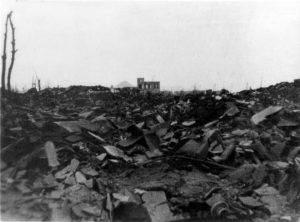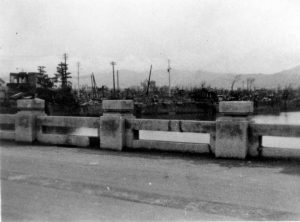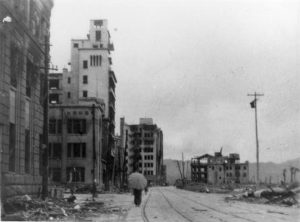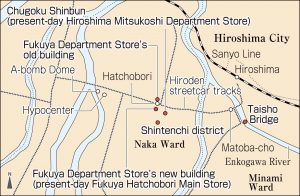Striving to fill voids in Hiroshima, evidence of victims remains — Disaster-stricken city reduced to rubble
Aug. 6, 2022
Hiroaki Shimoda, 18-year-old student at time
Passing on photos from 77 years ago to future generations
by Kyosuke Mizukawa, Senior Staff Writer
Seven photographs taken in the city limits of Hiroshima immediately after the atomic bombing and recently provided to the Chugoku Shimbun by Hiroaki Shimoda, 95, a resident of the city’s Nishi Ward, display the areas devastated by the atomic bombing around the busy shopping district of Hatchobori (in Hiroshima’s present-day Naka Ward) and urban panoramas near the train hub of Hiroshima Station (in present-day Minami Ward). Seventy-seven years later, photos that convey the actual devastation resulting from the atomic bombing are now more important than ever. Mr. Shimoda, himself an A-bomb survivor, hopes his photos will help pass on memories of the atomic bombing to future generations.
One of the photographs was taken from the southeast side of the new building of the Fukuya Department Store (now the Fukuya Hatchobori Main Store) facing the district of Shintenchi (in Hiroshima’s Naka Ward) to the south. The area, where numerous stores, including movie theaters, restaurants, clothing stores, and so on stood before the atomic bombing, was burned to the ground and covered in rubble after the bombing. Only the Tada Pediatric Clinic, a two-story ferroconcrete building that survived the fires, is clearly visible. With no buildings obstructing the view, Ninoshima Island (now part of Hiroshima’s Minami Ward), located approximately eight kilometers to the south, can clearly be seen.
The other photos show streetcar tracks almost completely absent people and the Kirin Beer Hall (present-day Hiroshima PARCO Main Wing), the windows of which had been blown out. Captured in the photos are locations that once bustled with crowds of people. Based on damage done to the windows of the Chugoku Shimbun office building, the Hiroshima Peace Memorial Museum (located in city’s Naka Ward) confirmed that some of the photos had been taken prior to September 1945, one month after the atomic bombing.
To further establish exactly when the photos were taken, the museum has focused on a photo taken from atop the Taisho Bridge, located to the south of Hiroshima Station, showing the incinerated ruins of the surrounding area. Taisho Bridge lost part of its girders in the Makurazaki Typhoon on September 17, 1945, making it highly likely that the photo was taken on the bridge before the girders were washed away in the storm. Nevertheless, the possibility cannot be denied that the photo was taken on the damaged bridge after the typhoon, and with that, the museum continues its efforts to verify the exact timing.
Mr. Shimoda has kept in his possession a letter that his uncle, Tadao Nakano (who died in 1992 at the age of 79), sent him along with photos. The letter reads, “These photos were taken in Hiroshima after the atomic bombing, and I’ve enclosed them as a keepsake for you.” Mr. Nakano, from the area of Kabe-cho (now part of Hiroshima’s Asakita Ward), was drafted by the military during the war and afterward moved to Osaka, where he ran a hardware manufacturing and sales business. Neither Mr. Shimoda nor Mr. Nakano’s family knows much about how or why the photos were taken.
Mr. Shimoda experienced the atomic bombing, suffering burns as a result, when he was an 18-year-old student 77 years ago while at his family home near Misasa National School (present-day Misasa Elementary School, in Hiroshima’s Nishi Ward), about two kilometers from the hypocenter. His father, Torazo, then 47, who was engaged in demolition work to create fire lanes, was killed in the atomic bombing. “My hope is that young people unfamiliar with the A-bombing will look at the photos at events commemorating August 6 and learn about the reality of the atomic bombing,” said Mr. Shimoda. He remarked that he intends to donate his photos to the museum.
(Originally published on August 6, 2022)











